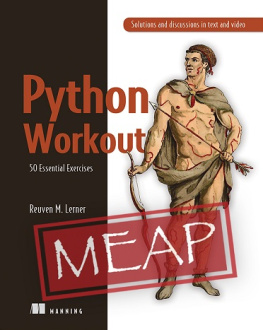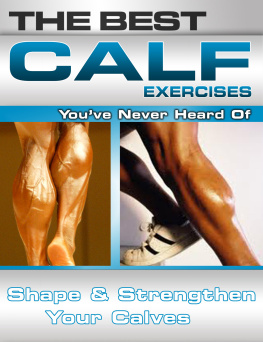Reuven M. Lerner - Python Workout: 50 Essential Exercises (Early Access v03)
Here you can read online Reuven M. Lerner - Python Workout: 50 Essential Exercises (Early Access v03) full text of the book (entire story) in english for free. Download pdf and epub, get meaning, cover and reviews about this ebook. year: 2020, publisher: Manning Publications Co., genre: Home and family. Description of the work, (preface) as well as reviews are available. Best literature library LitArk.com created for fans of good reading and offers a wide selection of genres:
Romance novel
Science fiction
Adventure
Detective
Science
History
Home and family
Prose
Art
Politics
Computer
Non-fiction
Religion
Business
Children
Humor
Choose a favorite category and find really read worthwhile books. Enjoy immersion in the world of imagination, feel the emotions of the characters or learn something new for yourself, make an fascinating discovery.
- Book:Python Workout: 50 Essential Exercises (Early Access v03)
- Author:
- Publisher:Manning Publications Co.
- Genre:
- Year:2020
- Rating:5 / 5
- Favourites:Add to favourites
- Your mark:
- 100
- 1
- 2
- 3
- 4
- 5
Python Workout: 50 Essential Exercises (Early Access v03): summary, description and annotation
We offer to read an annotation, description, summary or preface (depends on what the author of the book "Python Workout: 50 Essential Exercises (Early Access v03)" wrote himself). If you haven't found the necessary information about the book — write in the comments, we will try to find it.
Python Workout: 50 Essential Exercises (Early Access v03) — read online for free the complete book (whole text) full work
Below is the text of the book, divided by pages. System saving the place of the last page read, allows you to conveniently read the book "Python Workout: 50 Essential Exercises (Early Access v03)" online for free, without having to search again every time where you left off. Put a bookmark, and you can go to the page where you finished reading at any time.
Font size:
Interval:
Bookmark:


You can download the most up-to-date version of your electronic books from your Manning Account at .
Manning Publications Co. We welcome reader comments about anything in the manuscript - other than typos and other simple mistakes. These will be cleaned up during production of the book by copyeditors and proofreaders.
https://livebook.manning.com/#!/book/python-workout/discussion
Hi, and thanks so much for purchasing the MEAP of the Python Workout: 50 Essential Exercises!
Over the last few years, Python has made inroads into many areas, including system administration, data science, devops, text processing, and Web development. As such, there are now many courses and books that aim to teach you Python.
Indeed, I spend just about every day teaching Python at companies around the world. It's fun and exciting to see so many people learning Python, getting more done in less time and enjoying themselves along the way.
For many years, my students would consistently ask one question after taking my courses: Where can we go to practice the Python we've just learned?
It shouldn't surprise me that they would want such practice. Athletes don't just hop onto the field and start to play, even if they're good at what they do; they're constantly improving and sharpening their skills. Even if you understood everything that the teacher said in your high-school math class, you still needed to practice, in order to ensure that it sank in. And anyone who has learned a foreign language knows that there's a world of difference between speaking in class, and using it in a real-world setting.
And indeed, learning a programming language is much like learning a human language: You need to understand its underlying structure, its nouns and verbs, and the ways in which you can and cannot express yourself. Over time, these rules become natural, and you find yourself able to express more complex ideas without having to refer to a translation guide, such as a phrasebook or Stack Overflow.
My goal in this book is to reinforce the ideas that you learned in your initial Python course, or when reading your first Python book. As you do each exercise, you'll probably struggle and feel some frustration. And when you see my solutions, you might well say, "Oh, of course! Why didn't I think of that?" These are normal parts of the learning process. Better to experience them in this book, as you gain fluency, than at work, on a problem that requires your attention.
The book is divided into 10 chapters, each covering a different area of Python. Overall, the problems get more complex as the book progresses but that doesn't mean I'll wait to use functions until the "functions" chapter, or comprehensions until the "functional programming" chapter. You should use whatever tool you think is necessary.
Each chapter starts with a reference table, including links, pointing to resources that might help you to better understand topics that you've forgotten or never learned. I hope that these will help you to reinforce your Python understanding, beyond the book itself.
In addition to the exercises and solutions, there are also videos, in which I demonstrate solving each of the problems, and add to the discussion I present in the book. The solutions are the same as the ones you can read in the book, but for many people, the videos make the process come alive a bit more; you'll get more of the feel of being in one of my live training sessions. In addition, it's often helpful to see the coding and solving process happen over time, rather than seeing it all at once on the page. The best way to use the video segments is to have the book and the video (in Manning's liveVideo platform) open at the same time. For each exercise, start with the book, complete each exercise, and, if you like, read the solution and discussion. Then click on the corresponding video segment to see me demo the solution and offer further insights to the discussion.
If there's one request that I have from you, it's that you not look at the exercise, think about how to solve it, and look at the solution. The real and deep learning doesn't happen that way, much as we might like to think otherwise. Only through actually trying to answer the exercise will you truly learn and improve your fluency.
When you complete an exercise, don't just read the solution, either. Just as important as seeing the code is understanding why and how I arrived at that code. The process I use for finding a solution is a key factor in your learning. I've thus not only spelled out my process, but also provided (whenever possible) with a link to the code in the Python Tutor, a fantastic online resource for anyone teaching or learning Python. I encourage you to use this link to experiment with the code, and get a visual sense of the data structures involved.
The book reached its present form thanks to questions, suggestions, and feedback from the students I've taught around the world. If you find a bug, either in the code or in the explanations, then please don't hesitate to be in touch, using the liveBook Discussion Forum. I'll be delighted to hear from you, and to incorporate your suggestions into this book, as well as the exercises I continue to develop and use in my teaching.
Reuven M. Lerner
Note: The current videos reference Python 2; they will be replaced with videos that use Python 3 and have improved audio and video quality.
Each project in this book comes with a companion video. These video modules provide a demonstration of the solution presented in the book, as well as additional explanation and insight. These videos are optional but extremely valuable discussions along with screencasts of the coding. They are the next best thing to being in the room at one of Reuven's live training sessions.
For now, the videos are available in Mannings liveBook platform. If you are reading this book in another format (pdf, ebook, etc), to access the videos, please log into your Manning account and navigate to the liveBook format.
To make the most of the projects, remember, the best learning comes from doing! So start with the book, reading the introduction to a chapter, to get a general understanding of the topic and the resources you might use to complete each project . Then read the problem, work through it, come up with a solution. Compare your solution to the answer, and read through the discussion to see how Reuven got to his answer.
Now, turn to the video for a demonstration of Reuven working through the problem and demonstrating how he arrived at the solution.
What's most important is that you work out your own solution before you check the answers in the book or watch the explanations in the videos. Again, the best learning comes from doing!

Functional programming
Modules
Objects
Iterators and generators
Appendixes
Resources
In Python, we have three different numeric types: int, float, and complex
Font size:
Interval:
Bookmark:
Similar books «Python Workout: 50 Essential Exercises (Early Access v03)»
Look at similar books to Python Workout: 50 Essential Exercises (Early Access v03). We have selected literature similar in name and meaning in the hope of providing readers with more options to find new, interesting, not yet read works.
Discussion, reviews of the book Python Workout: 50 Essential Exercises (Early Access v03) and just readers' own opinions. Leave your comments, write what you think about the work, its meaning or the main characters. Specify what exactly you liked and what you didn't like, and why you think so.









